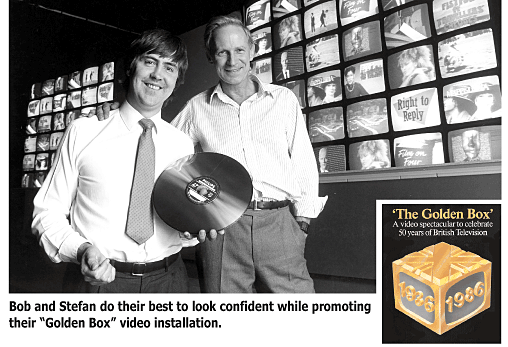 LONDON UK, 1986. That’s me on the right up there. I may be smiling, but I’m afraid, very afraid. After this photo shoot, we planned to show that video wall to an audience of trade press and VIPs from British broadcasting. It’s a 70-minute production called “The Golden Box.” Gold for 50 years and Box for television: Golden Box = 50 years of television! You got it! My client was the esteemed Royal Television Society.
LONDON UK, 1986. That’s me on the right up there. I may be smiling, but I’m afraid, very afraid. After this photo shoot, we planned to show that video wall to an audience of trade press and VIPs from British broadcasting. It’s a 70-minute production called “The Golden Box.” Gold for 50 years and Box for television: Golden Box = 50 years of television! You got it! My client was the esteemed Royal Television Society.
The setup: 36 screens on each side of a 12’ Eidophor rear-projection center screen. Take a close look at the photo. Where’s the center screen? Hey, it’s behind our heads, but even for this PR photo. they couldn’t power it up and put an image on it.
On the left, with his thumb stuck in the LaserVision disc, is my colleague, Bob Auger. Poor guy, he’s smiling as hard as he can, but he’s faking too. The sad truth is that the wall has never had a non-stop, successful run. Behind it are 10 Philips CAV LaserVision players (Laserdisc in the U.S.) linked via computer. Five discs play the first 35 minutes and then the other five take over. Well, that was the plan, but it never happened, and the techies from Philips Eindhoven were frantically trying to fix it by writing more code in BCPL, Basic Combined Programming Language.
And we’re running out of time.
Another test run… 33, 34, 35 minutes — here comes the Mickey Mouse cartoon that played as the BBC closed down their transmitters in 1939 for the war. Now the disc crossover… wait for it… wait for it… nothing… just 73 blank screens and an eerie silence.
Plan BCEP, our Basic Combined Exit to Patagonia.
THE BACK STORY. I fly to Philips’ HQ in Eindhoven, Holland. Tony Pilgrim of the RTS has convinced them to donate a video wall for the event. Mr. Philips says to me, “How many monitors would you like?”
“How many can I have?”
“Whatever you want – 1 to 100.”
We fly back to London. On the plane, I finally ask Tony, “What kind of show do you imagine?”
“Oh, something like a feature film. You know, about 90 minutes.”
Wow, I’m to write and direct a feature-length show to play on maybe 100 screens. This is exciting! I work out that 36 television monitors on either side of a center screen would fit the theater. Tony gets Eidophor to donate a projector. I hire Bob to co-produce and look after the wall. Both of us are willing innocents, going where angels fear to tread.
I take on assistants and researchers. The BBC and all the commercials stations send us their best work over the past 50 years. Monty Python and Fawlty Towers spring to mind, but there are thousands more — remember Thunderbirds and The Prisoner? Not to mention documentaries, sports and royal events.
Tony was a transmitter guy. He wants a special section on THE MARCH OF THE TELEVISION TOWERS.
Nooooo… !
“Do it!” he shouts.
Surprise. It’s terrific.
A CAV Laserdisc can hold 36 minutes in PAL. Want more? Just add players. Philips execs say it’s possible. I believe them. Now their video wall expert tells me their previous longest presentation was just 10 minutes long. A ton of memory and new code are needed.
While I concentrate on the center screen story, Bob plans the video wall montages. We record the show with nine 1″ VTRs. Fly the tapes to Philips. Get the LP-sized discs made and slowly die as their expert programs the show, frame by frame. Discs 1, 2, 3 and discs 7,8, 9 run in real time, while all the others are random-access for special effects, freeze frames and last-minute additions.
CRUNCH TIME — THE PREMIERE. There are speeches first. Everyone has his say except Bob and me. We’re only the guys who wrote, directed, edited, and sweated blood.
The show starts. Looks great. Here we go — 33, 34, 35… Mickey Mouse cartoon… wait for it… and… a miracle! Part two starts and plays. For the first time ever!
I’m not going to Patagonia.
You can see a center screen clip at https://stefansargent.com/goldenbox.html
